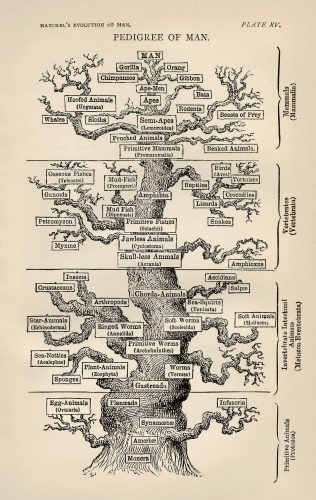Image courtesy of Tree of Life, from The Evolution of Man, Ernst Haeckel, 1879.
Professor Walter Jetz’s biology lab at Yale University studies trees of evolutionary heritage known as phylogenies, as part of a project to reconstruct the tree of life for all terrestrial vertebrates globally (about 33,000 living species of mammals, birds, amphibians, and reptiles). A recent publication headed by Nathan Upham questions the current supertree model, which merges overlapping phylogenetic trees based on available but incomplete DNA data, inducing major biases. Upham’s team has shown that examining only one path of evolutionary history, as supertrees do, is arbitrary because there are multiple unique paths that match the data just as well.
Upham and his team developed a method for displaying the uncertainty associated with such a tree—the “backbone-and-patch” method. The method starts with creation of a “backbone” corresponding to a major lineage of mammals and attaches patches—sets of species that are expected to have broken off from the backbone around the same time—to the backbone. The team estimates the different “patches” of evolutionary relationships within a group of species through assumptions regarding divergence time. They also draw possible divergence points for species with no DNA data in order to include all living species.
The researcherstook 5,911 mammalian species and, utilizing computer modelling, generated ten thousand different possible speciation paths, with each path making a different assumption as to when past speciation took place. The backbone-and-patch method generates many large trees that all match the data, enabling studies of what steps eventually cause speciation.
The Jetz lab developed this alternative to supertree phylogenies to promote a deeper understanding of evolutionary rates. As for the future, “The lab is looking into this divergence-time uncertainty to better understand what kind of mammalian behaviors might cause genetic divergence, and how genetically different two populations need to be before becoming separate species,” Upham said.

